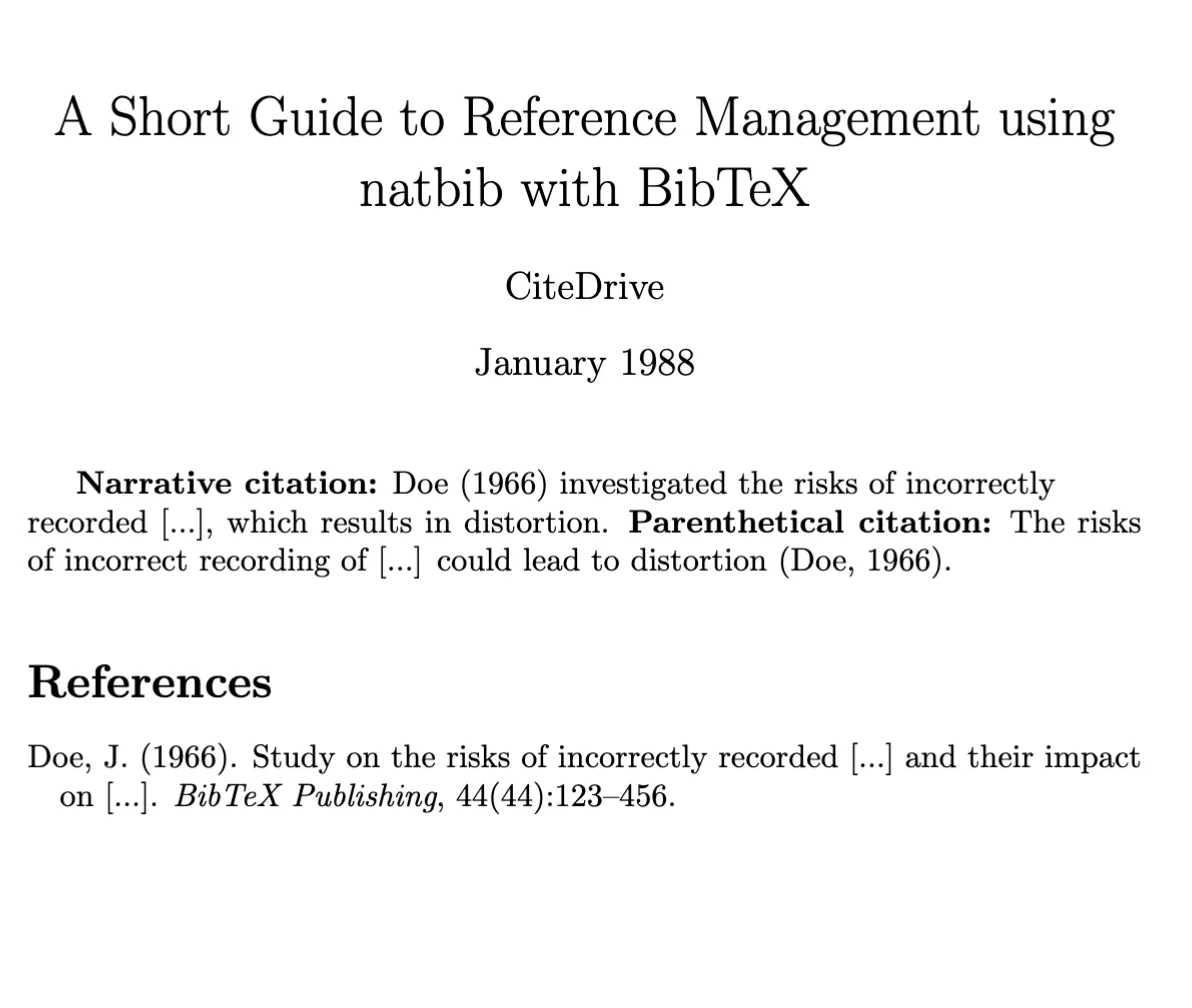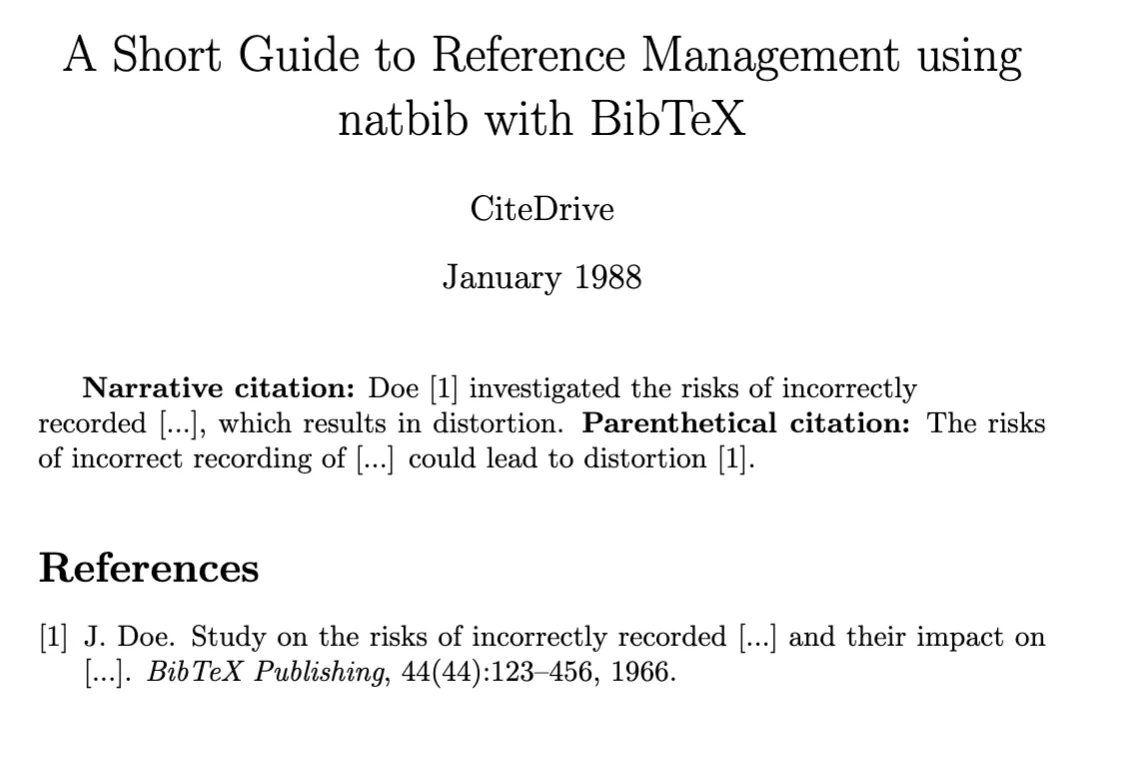Natbib Tutorial: LaTeX'te BibTeX ile Referans Yönetimini Öğrenme
LaTeX’te bibliyografik referansları yönetmek, natbib paketini kullanarak daha verimli ve düzenli hale gelir. İster geleneksel \cite{*} komutuyla çalışıyor olun, ister gelişmiş alıntı yöntemlerine dalıyor olun, bu kılavuz, başlamanız için temel bilgileri sunmaktadır.
natbib’e Giriş ve Güçlü Yönleri
natbib paketi, LaTeX’teki standart \cite{*} komutunun yeteneklerini genişletir. Özellikle, çeşitli seçenekler ve özelleştirmelerle metin içi alıntılarda, özellikle yazar-yıl sistemleri ve BibTeX ile entegre olduğunda metinsel ve parantezli alıntıları görüntülemede başarılıdır.
Şimdi, natbib’in gücünü nasıl kullanacağınızı ve bibliyografik kaynaklarınızı nasıl biçimlendireceğinizi öğrenelim.
Yolculuğunuza Başlangıç: natbib ile Parantezli ve Metinsel/Narratif Metin İçi Alıntılar
natbib’i kurmak, standart LaTeX kurulumuna benzer bir yapı gerektirir. Başlamak için \usepackage{natbib} komutunu kullanarak kütüphaneyi yükleyin. Kütüphane, aşağıda detaylı olarak tartışılacak olan birkaç yapılandırma seçeneği sunar. Natbib’in ana alıntı komutları \citet{*} (metinsel/narratif alıntılar için) ve \citep{*} (parantezli alıntılar için) dir.
\documentclass{article}\usepackage{natbib}\bibliographystyle{apalike}\title{natbib ve BibTeX Kullanarak Referans Yönetimi için Kapsamlı Bir Kılavuz}\author{CiteDrive}\date {Ocak 1988}
\begin{document}
\maketitle\textbf{Narrative citation:} \citet{Doe:1966} yanlış kaydedilen [...]'in risklerini araştırdı, bu da bozulmaya yol açmaktadır.\textbf{Parenthetical citation:} Yanlış kaydedilen [...]'in riskleri bozulmaya yol açabilir \citep{Doe:1966}.
\medskip
\bibliography{sample}
\end{document}\bibliography{sample} komutunu kullanarak LaTeX’e .bib dosyanızın yerini belirtirsiniz, bu dosyada bibliyografik girişler bulunur:
@article{Doe:1966, title = {Yanlış Kaydedilen [...]'in Riskleri ve Bunların [...] Üzerindeki Etkileri.}, author = {John Doe}, year = 1966, journal = {BibTeX Yayıncılığı}, volume = 44, number = 44, pages = {123--456}}@article{smith2017, title = {İlginç Bir Makale}, author = {John Smith}, year = {2017}, journal = {İlginç Makaleler Dergisi}} natbib ile BibTeX kullanarak referans yönetiminin çıktı örneği
natbib ile BibTeX kullanarak referans yönetiminin çıktı örneği
Sayısal alıntı stillerine ilgi duyanlar için, natbib’i nasıl uyarlayacağınız aşağıda gösterilmektedir:
\usepackage[square,numbers]{natbib}\bibliographystyle{abbrvnat} natbib ile BibTeX kullanarak sayısal stil ile referans yönetiminin çıktı örneği
natbib ile BibTeX kullanarak sayısal stil ile referans yönetiminin çıktı örneği
Derinlemesine İnceleme: natbib’deki cite{*} Komutlarını Keşfetmek
natbib tarafından sunulan cite{*} komutlarının yelpazesi, kaynakları verimli bir şekilde alıntılamanızı sağlar. Aşağıdaki tablo, bunların çıktılarının nasıl olduğunu açıklar:
| Komut (Tekli alıntı) | Çıktı (yazar-yıl) | Çıktı (Sayısal) | Komut (Birden fazla alıntı) | Çıktı (yazar-yıl) | Çıktı (Sayısal) |
|---|---|---|---|---|---|
\citet{Doe:1966} | Doe (1966) | Doe [1] | \citet{Doe:1966,smith2017} | Doe (1966); Smith (2017) | Doe [1], Smith [2] |
\citet[chap.~4]{Doe:1966} | Doe (1966, chap. 4) | Doe [1, chap. 4] | \citet[chap.~4]{Doe:1966,smith2017} | Doe (1966); Smith (2017, chap. 4) | Doe [1], Smith [2, chap. 4] |
\citep{Doe:1966} | (Doe, 1966) | [1] | \citep{Doe:1966,smith2017} | (Doe, 1966; Smith, 2017) | [1, 2] |
\citep[chap.~4]{Doe:1966} | (Doe, 1966, chap. 4) | [1, chap. 4 | \citep[chap.~4]{Doe:1966,smith2017} | (Doe, 1966; Smith, 2017, chap. 4) | 1, 2, chap. 4] |
\citep[see][]{Doe:1966} | (see Doe, 1966) | [see 1] | \citep[see][]{Doe:1966,smith2017} | (see Doe, 1966; Smith, 2017) | [see 1, 2] |
\citep[see][chap.~4]{Doe:1966} | (see Doe, 1966, chap. 4) | [see 1, chap. 4] | \citep[see][chap.~4]{Doe:1966,smith2017} | (see Doe, 1966; Smith, 2017, chap. 4) | [see 1, 2, chap. 4] |
\citet*{Doe:1966} | Doe (1966) | Doe [1] | \citet*{Doe:1966,smith2017} | Doe (1966); Smith (2017) | Doe [1], Smith [2] |
\citep*{Doe:1966} | (Doe, 1966) | [1] | \citep*{Doe:1966,smith2017} | (Doe, 1966; Smith, 2017) | [1, 2] |
Diğer natbib komutları, \citealp ve \citealt, parantezleri gizleyerek ek esneklik sunar. Tüm komutlar hakkında bilgi için natbib kullanımına dair referans dökümantasyonunu inceleyin.
Ekstra: natbib İçin Seçenekleri Öğrenmek
natbib ile çalışırken, davranışını özelleştirmek iş akışınızı daha verimli hale getirebilir. İşte \usepackage[options]{natbib} komutuyla erişilebilen seçeneklerin bir özeti:
| Seçenek | Açıklama |
|---|---|
| round | yuvarlak parantezler gösterir |
| square | kare köşeli parantezler gösterir |
| curly | küme parantezleri gösterir |
| angle | açı parantezleri gösterir |
| semicolon | birden fazla alıntı noktalı virgül ile ayrılır |
| colon | aynı noktalama gibi |
| comma | birden fazla alıntı virgülle ayrılır |
| authoryear | yazar-yıl alıntılarını gösterir |
| numbers | sayısal alıntıları gösterir |
super|üst simge stili için|
Özet: Daha Etkili Alıntı ve Bibliyografik Yönetim İçin Natbib’i Keşfedin
Bu kapsamlı rehber, natbib paketinin özelliklerini ve nasıl kullanıldığını tanıttı. Artık, alıntı stilleriyle istediğiniz gibi özelleştirilmiş bir sistem kurarak LaTeX’teki referans yönetimini kolaylaştırabilirsiniz. Unutmayın, doğru bibliyografik alıntılama için hem akademik yazımda hem de araştırma sürecinde doğru araçları kullanmak çok önemlidir.